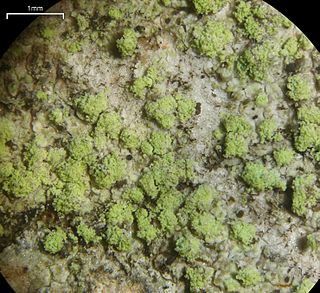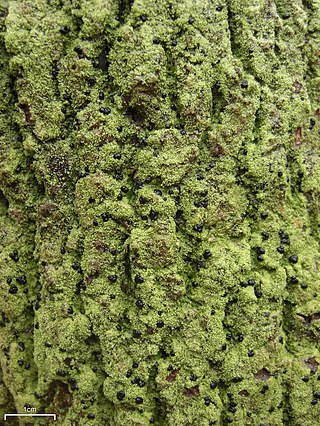
The Pannariaceae are a family of lichens in the order Peltigerales. Species from this family have a widespread distribution, but are especially prevalent in southern temperate regions.

Biatora is a genus of lichens in the family Ramalinaceae. First described in 1817, the genus consists of crustose and squamulose lichens with green algal photobionts, biatorine apothecia, colorless, simple to 3-septate ascospores, and bacilliform pycnospores. According to the Dictionary of the Fungi, the genus contains 42 species that are widely distributed in temperate areas.

Bacidina is a genus of lichens in the family Ramalinaceae. It was circumscribed by Czech lichenologist Antonín Vězda in 1990, with Bacidina phacodes assigned as the type species. Vězda included 11 species in Bacidina, which was originally classified in the Lecideaceae. These species had previously been placed in genus Bacidia.

Bacidia is a genus of lichen-forming fungi in the family Ramalinaceae. The genus was circumscribed by Giuseppe De Notaris in 1846. Species in the genus are crust-like lichens with stemless apothecia; they have green algae (chloroccoid) as photobionts. Their asci have 8 colorless, cylindrical to acicular, multiseptate spores, with curved and thread-like conidia.

Lecania is a genus of lichenized fungi in the family Ramalinaceae. The genus was circumscribed by Abramo Bartolommeo Massalongo in 1853. Lecania is widely distributed, especially in temperate regions, and contains about 64 species.

Micarea is a genus of lichenized fungi in the family Pilocarpaceae. The widely distributed genus contains 126 species and new species are described actively. Species in the genus are crustose lichens and their photobiont is a single-celled green alga.
Bryonora is a genus of crustose lichens in the family Lecanoraceae. The genus was circumscribed in 1983 by lichenologist Josef Poelt, with Bryonora castanea assigned as the type species.

Miriquidica is a genus of lichen in the family Lecanoraceae. The genus was circumscribed in 19876 by lichenologists Hannes Hertel and Gerhard Rambold, with Miriquidica complanata assigned as the type species. According to Dictionary of the Fungi, the widespread genus contains 23 species, found predominantly in arctic-alpine regions.

Porpidia is a genus of crustose lichens in the family Lecideaceae.

Rhizocarpon is a genus of crustose, saxicolous, lecideoid lichens in the family Rhizocarpaceae. The genus is common in arctic-alpine environments, but also occurs throughout temperate, subtropical, and even tropical regions. They are commonly known as map lichens because of the prothallus forming border-like bands between colonies in some species, like the common map lichen.

Fuscidea is a genus of crustose lichens in the family Fuscideaceae. It has about 40 species. The genus was circumscribed in 1972 by lichenologists Volkmar Wirth and Antonín Vězda, with Fuscidea aggregatilis assigned as the type species.

Coccotrema is a genus of lichen-forming fungi. It is the type genus of the family Coccotremataceae, in the order Pertusariales. The genus contains 16 species.

Tephromela is a genus of lichens in the family Tephromelataceae. There are about 25 species in this widespread genus.

Palicella is a genus of crustose lichens in the family Lecanoraceae. It contains five species.

Hymenelia is a genus of lichen-forming fungi belonging to the family Hymeneliaceae.

Halecania is a genus of fungi in the family Leprocaulaceae. It has 22 species. The genus was circumscribed by Austrian lichenologist Michaela Mayrhofer in 1987, with Halecania alpivaga assigned as the type species. She created Halecania to contain species, formerly placed in Lecania, with the following characteristics: uniformly amyloid apical domes, paraphyses with dark brown apical caps, and halonate ascospores.
Lambiella is a genus of lichen-forming fungi in the family Xylographaceae. The genus was circumscribed by German botanist Hannes Hertel in 1984, with Lambiella psephota assigned as the type species.
Tephromela lignicola is a species of lignicolous (wood-dwelling), crustose lichen in the family Tephromelataceae. It is found in the Falkland Islands, where it grows on fenceposts and similar timber.















